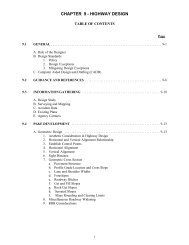Baltimore-Washington Parkway Widening Feasibility Study
Baltimore-Washington Parkway Widening Feasibility Study
Baltimore-Washington Parkway Widening Feasibility Study
- No tags were found...
You also want an ePaper? Increase the reach of your titles
YUMPU automatically turns print PDFs into web optimized ePapers that Google loves.
<strong>Baltimore</strong>-<strong>Washington</strong> <strong>Parkway</strong> <strong>Widening</strong> <strong>Feasibility</strong> <strong>Study</strong><strong>Study</strong> BackgroundThe 1940s brought an emphasis on roadway projectsimportant to national defense, leading to the FederalDefense Highway Act of 1941, which provided funds forinfrastructures that addressed primarily nationaldefense needs. The Department of Commerce’s FederalWorks Agency (the agency that oversaw the Bureau ofPublic Roads, which would later become the FHWA),restricted approval to road projects that wereconsidered essential to national defense. Under thesecircumstances, the characteristics described by a typicalparkway provided for a more functional defense roadway system connecting to Fort George G. Meade,one of the largest military bases in the United States, than the typical freeway or highway because theB-W <strong>Parkway</strong> would be impermeable to an air attack due to its context-sensitive design, and theparkway would have limited access which permitted easy closure to non-military traffic in times ofemergency 3 .This focus on national defense led to a plan for the B-W <strong>Parkway</strong> that merged the functionality ofmodern freeways with the scenic parkway characteristics that addressed the aesthetic value andnational defense needs. In 1945, the plans were finalized, which significantly differed from the initialplans. The northern section of the corridor between Fort Meade and the city of <strong>Baltimore</strong> wasdesignated under the jurisdiction of the State of Maryland, and the typical public highway designstandards of the time were applied. Additionally, as a State-owned roadway, it was built toaccommodate commercial vehicles. The southern portion of the planned parkway remained underfederal jurisdiction as much of the land was owned by Fort Meade and other Federal agencies. Adecision was made to abide by the parkway standards of the NPS, which was granted ownership andmaintenance responsibilities for this portion of the corridor. This portion of the corridor would alsoenact a prohibition on commercial vehicles. Construction began in 1946 on the 12-mile section of thenorthern portion of the corridor between <strong>Baltimore</strong> and MD 175, and the parkway was opened in 1952.The construction of the 19-mile segment between MD 175 and New York Avenue/U.S. Route 50 and theboundary with the District of Columbia began in 1950 and was opened in 1954.To ensure that the parkway maintained its primary purpose, congressional legislation was approved in1950 for the B-W <strong>Parkway</strong> 4 . The legislation states that it “… shall be regarded as an extension of thepark system of the District of Columbia and its environs...” and “…that it shall be constructed,developed, administered, and maintained by the Secretary of the Interior, through the National ParkService…” in accordance with the National Park Service 1916 mission which protects natural and3 United States Department of the Interior, National Park Service, National Register of Historic Places Multiple PropertyDocumentation Form, Section E - Statement of Historic Context, p174 Public Law 643 – 81st Congress, Chapter 525 – 2D Session, H.R. 599018 November 2012
















